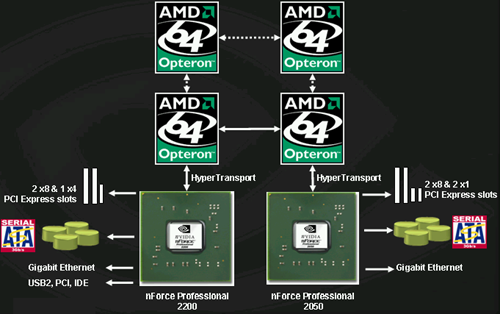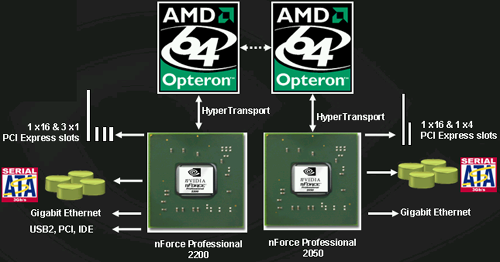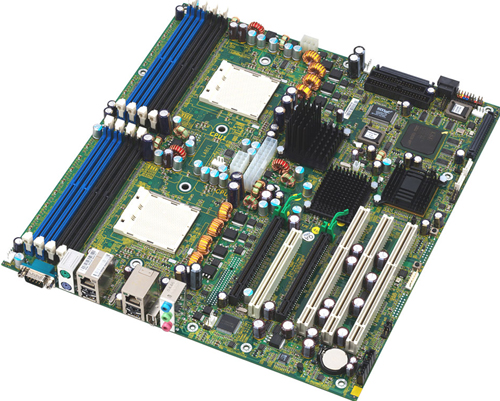NVIDIA nForce Professional Brings Huge I/O to Opteron
by Derek Wilson on January 24, 2005 9:00 AM EST- Posted in
- CPUs
The Kicker(s)
On server setups with available HyperTransport lanes to processors, up to 3 nForce Pro 2050 MCPs can be added alongside a 2200 MCP.
As each MCP makes a HT connection to a processor, a dual or quad processor setup is required for a server to take advantage of 3 2050 MCPs (in addition to the 2200), but in the case where such I/O power is needed, the processing power would be an obvious match. It is possible for a single Opteron to connect to one 2200 and 2 2050 MCPs for slightly less than the maximum I/O, as any available HyperTransport link can be used to connect to one of NVIDIA's MCPs. Certainly, the flexibility now offered by AMD and NVIDIA to third party vendors has been increased multiple orders of magnitude.
So, what does a maximum of 4 MCPs in one system get us? Here's the list:
- 80 PCI Express lanes across 16 physical connections
- 16 SATA 3Gb/s channels
- 4 GbE interfaces
Keep in mind that these features are all part of MCPs connected directly to physical processors with 1GHz HyperTransport connections. Other onboard solutions with massive I/O have provided multiple GbE, SATA, and PCIe lanes through a south bridge, or even the PCI bus. The potential for onboard scalability with zero performance hit is staggering. We wonder if spreading out all of this I/O across multiple HyperTransport connections and processors may even help to increase performance over the traditional AMD I/O topography.

Server configurations can drop an MCP off of each processor in an SMP system.
The fact that NVIDIA's RAID can span across all of the devices in the system (all 16 SATA 3Gb/s and the 4 PATA devices from the 2200) is quite interesting as well. Performance will be degraded by mixing PATA and SATA devices (as the system will have to wait longer on PATA drives), and likely, most will want to keep RAID limited to SATA. We are excited to see what kind of performance that we can get from this kind of system.
So, after everyone catches their breath from the initial "wow" factor of the maximum nForce Pro configuration, keep in mind that this will only be used in very high end servers using Infiniband connections, 10 GbE, and other huge I/O interfaces. Boards will be configured with multiple x8 and x4 PCIe slots. This will be a huge boon to the high end server market. We've already shown the scalability of the Opteron at the quad level to be significantly higher than Intel's Xeon (single front side bus limitations hurt large I/O), but unless Intel has some hidden card up their sleeve, this new boost will put AMD based high end servers well beyond the reach of anything that Intel could put out in the near term.
On the workstation side, NVIDIA will be pushing dual processor platforms with one 2200 and one 2050 MCP. This will allow the following:
- 40 PCI Express lanes across 8 physical connections
- 8 SATA 3Gb/s channels
- 2 GbE interfaces

This is the workstation layout for a DP NFPro system.
Again, it may be interesting to see if a vendor will come out with a single processor workstation board requiring an Opteron 2xx to enable a 2200 and 2050. This way, a single processor workstation could be had with all the advantages of the system.

IWill is shipping their DK8ES as we speak and should have availability soon.
While NVIDIA hasn't announced SLI versions of Quadro or support for them, boards based on the nForce Pro will support SLI version of Quadro when available. And the most attractive feature of the nFroce Pro when talking about SLI is this: 2 full x16 PCI Express slots. Not only do both physical x16 slots have all x16 electrical connections, but NVIDIA has enough headroom left for an x4 slot and some x1 slots as well. In fact, this feature is big enough to be a boon without the promise of SLI in the future. The nForce Pro offers full bandwidth and support for multiple PCI Express cards, meaning that multimonitor support on PCI Express just got a shot in the arm.
One thing that's been missing since the move away from PCI graphics cards has been multiple card support in systems. Due to the nature of AGP, running a PCI card alongside an AGP card is nice, but PCI cards are much lower performance. Finally, those who need multiple graphics cards will have a solution with support for more than one of the latest and greatest graphics cards. This means two 9MP monitors for some, and more than two monitors for others. And each graphics card has a full x16 connection back to the rest of the system.

Tyan motherboards based on nForce Pro are also shipping soon according to NVIDIA.
The two x16 connections will also become important for workstation and server applications that wish to take advantage of GPUs for scientific, engineering, or other vector-based applications that lend themselves to huge arrays of parallel floating point hardware. We've seen plenty of interest in doing everything from fluid flow analysis to audio editing on graphics cards. It's the large bi-directional bandwidth of PCI Express that enables this, and now that we'll have two PCI Express graphics cards with full bandwidth, workstations have even more potential.
Again, workstations will be able to have RAID across all 8 SATA devices and 4 PATA devices if desired. We can expect mid-range and lower end workstation solutions only to have a single nForce 2200 MCP on them. NVIDIA sees only the very high end of the market looking at pairing the 2200 with 2050 in the workstation space.
Perhaps the only down side to the huge number of potential PCI Express lanes available is the inability of NVIDIA MCPs to share lanes between MCPs and slight lack of physical PCI Express connections. In otherwords, it will not be possible to have a motherboard with 5 x16 PCI Express slots or 10 x8 PCI Express slots, even though there are 80 lanes available. Of course, having 4 x16 slots is nothing to sneeze at. On the flip side, it's not possible to put 1 x16, 2 x4, and 6 x1 PCIe slots on a dual processor workstation. Even though there are a good 16 PCI Express lanes available, there are no more physical connections to be had. Again, this is an extreme example, and not likely to be a real world problem. But it's worth noting nonetheless.










55 Comments
View All Comments
Dubb - Monday, January 24, 2005 - link
You should probably specify that the Iwill DK8ES is NOT a dual x16 board. it's x16+x2, with the x2 on a x16 connector. the DK8EW that will be released in a few months is x8 + x8.the tyan is the only x16 + x16 I know of so far...
feel free to correct me if I'm wrong, but the folks at 2cpu.com are pretty sure of this.
henry - Monday, January 24, 2005 - link
> #32 ... heh ... that's only 4 x1 lanes not 5 ;-) the config i mentioned is not possible.Check this: 1x16 + 3x1 / 1x4 + 2x1 (+ 1x8 for the fun ;-)
DerekWilson - Monday, January 24, 2005 - link
#32 ... heh ... that's only 4 x1 lanes not 5 ;-) the config i mentioned is not possible.And the Intel PCI-X idea is definitely funky :-) I suppose that would work. Rather than use an HT link for AMD's tunnel, that could interesting in a pinch. No matter how unlikely :-)
henry - Monday, January 24, 2005 - link
Hi DerekJust two remarks:
> On the flip side, it's not possible to put 1 x16, 1 x4, and 5 x1 PCIe slots on a dual processor workstation.
Why shouldnt this be possible: Just partition the PCIe lanes in this way: 1x16 + 3x1 on first nForce (one lane wasted) and 1x4 + 1x1 on second chip (still 15 lanes and two controllers left)
Regarding PCI-X: As you said mainboard makers can choose the obvious way and directly attach AMD's PCI-X tunnel chips.
Nevertheless there is a more insane option: Use a spare x4 or x8 PCIe link to hook up a PCI-X bridge chip (e.g. Intel 41210).
DerekWilson - Monday, January 24, 2005 - link
NCQ is native tagged command queuing for SATA ... TCQ is tagged command queuign for SCSI. WD called the Raptors initial support TCQ because they just pulled their SCSI solution over. This served to confuse people. SATA command queuing is NCQ. People call TCQ sometimes, and maybe that's fine. Really, they may as well be the same thing except that one is for SCSI.#25, SDA
I meant PCI-X -- NVIDIA didn't build in legacy PCI-X support to their MCPs. In order to support it it must be paired with AMD-8000 series. Intel has PCI-X support off MCH. If many PCI-X slots are required, the Intel solution must sacrifice some of its PCIe lanes for the 6700PXH 64-bit PCI Hub. This hub hooks into the E75xx though either a x4 or x8 PCIe lane to provide additional PCI/PCI-X buses. I know, it's a lot of PCI/PCIe/PCI-X ... sorry for the confusion.
Cygni - Monday, January 24, 2005 - link
btw, i was kidding about the windows thing...Cygni - Monday, January 24, 2005 - link
Nvidia is also releasing a new videocard that does all of that, plus the GPU can run windows!Countdown to the point where the video card becomes everything and the motherboard is a tiny piece of plastic that holds everything in place....
tumbleweed - Monday, January 24, 2005 - link
#26 - rumour has it that SS will be showing up in future NV 'video' cards, rather than on motherboards. With the ridiculous bandwidth overkill that is PCIe x16, that's a good place to put it, IMO. Save a slot, save mobo space, and put unused bandwidth to use.tumbleweed - Monday, January 24, 2005 - link
Derek - Dissonance over at TR says he specifically asked NV about it, and was told it supported TCQ as well as NCQ, so somebody is confused. :)AbRASiON - Monday, January 24, 2005 - link
I've made myself a little saying which I now apply to nvidia motherboards,...It's "no soundstorm, no sale"
Until they re-impliment it, I'm not buying one, period.